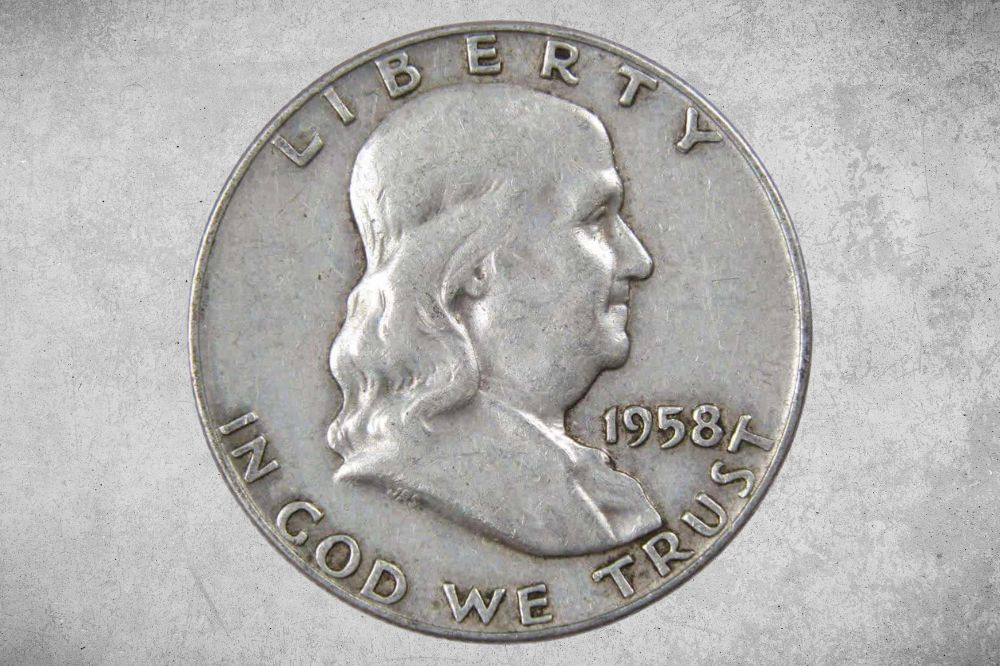Have you unexpectedly found a 1958 half dollar? Are you thinking of selling it but are worried about getting ripped off? If so, we have some good news for you – today’s post is designed to help you out.
In it, we’re going to explore the 1958 half dollar value, its history, key features, and common errors.
1958 Half Dollar Details
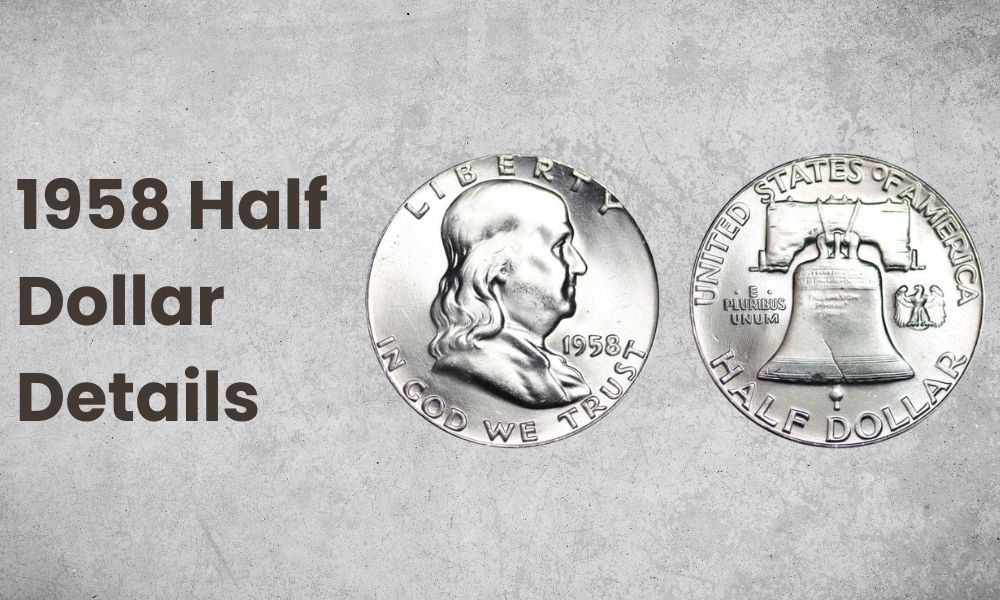
- Category: Franklin Half Dollars
- Total Mintage: 28,880,064
- Minting place: Philadelphia and Denver
- Diameter: 30.6 mm
- Weight: 12.5 g
- Edge: Reeded
- Original value: 50 cents ( $0.50)
- Composition: 10% copper and 90% silver
- Engraver: John R. Sinnock
The Obverse Design of the 1958 Half Dollar
The 1958 half dollar obverse bears the image of Benjamin Franklin, one of the United States’ founding fathers. It features his bust facing right; this is placed in the coin’s middle.
Some speculate that this bust was modeled after a sculptor made by Jean-Antoine Houdon. Underneath it, along the coin’s bottom edge is the inscription, “IN GOD WE TRUST.”
Between the last letter of the inscription and Franklin’s neck, there’s an engraving of the year 1958. Also, the word “LIBERTY” is engraved on the coin’s top edge, directly above Franklin’s head.
The coin’s designer, John R. Sinnock, also engraved his initials “JRS” where Franklin’s shoulder was cut off.
The Reverse Design of the 1958 Half Dollar
The reverse side of the 1958 50-cent coin has a Liberty bell in its center. This bell has a crack, just like the real one that cracked in 1752 after its first test ring.
There is an eagle engraved on the right side of the bell and “E PLURIBUS UNUM” is engraved on its left. Above the bell, along the coin’s edge, the words “UNITED STATES OF AMERICA” are written.
This engraving starts from the left and ends on the right. Below the bell, the words “HALF DOLLAR” are engraved along the coin’s bottom edge.
Other Features of the 1958 Half Dollar
Design aside, the 1958 half dollar has other interesting features. For one, it has a diameter of 30.6mm and a thickness of 1.8mm. Also, it has a weight of 12.5 g, 11.5 (90%) of which is silver; the rest is copper.
1958 Half Dollar Value Chart
| 1958 Half Dollar Value Chart | ||||
| Type | Average Circulated | Extremely Fine | About Uncirculated | Mint State |
| 1958 No Mint Half Dollar | $6.95 | $6.95 | $6.95 | $9.55 |
| 1958 “D” Half Dollar | $6.95 | $6.95 | $6.95 | $9.55 |
1958 Half Dollar Value and Varieties Guide
1958 No Mint Half Dollar Value
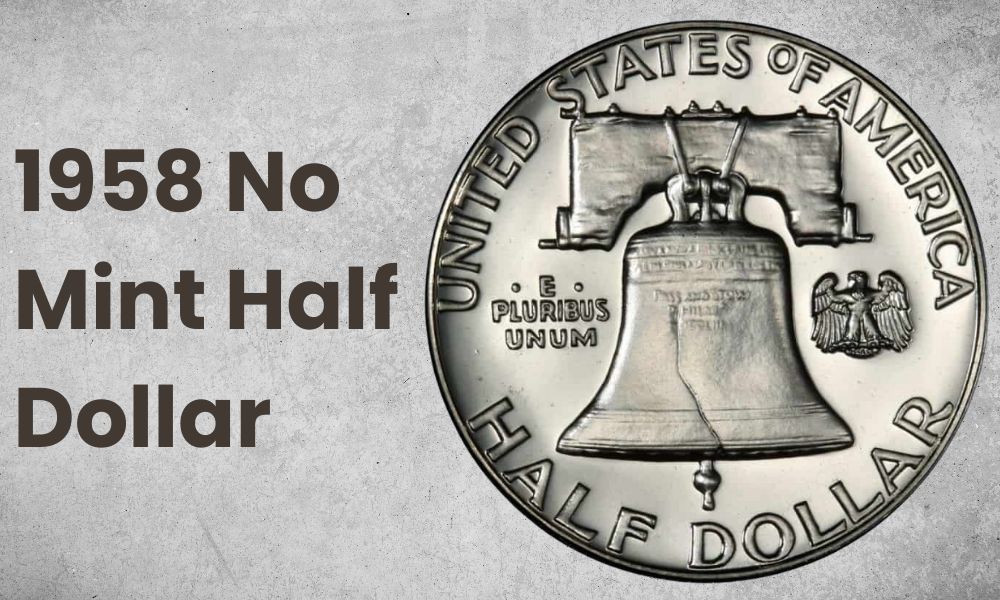
- Category: Franklin Half Dollar
- Mint: None
- Minting place: Philadelphia
- Year: 1958
- Edge: Reeded
- Mintage: 4,917,652
- Designer: John R. Sinnock
- Original value: 50 cents ($0.50)
- Current value: $6.95 to $9.55
- %Composition: 10% copper and 90% silver
- Mass: 12.5 g
- Diameter: 30.6 mm
The Philadelphia facility produced 4,042,000 regular-strike and 875,652 proof Franklin half dollars in 1958. They all didn’t have mint marks. Because of the low mintage of these coins, they are sought after by collectors to date.
Interestingly, they are still available at low prices, even the proof versions. An average-grade 1958 50-cent coin can go for $6.95 to $9. However, rare pristine mint states can cost as much as $1,280.
But mint state coins aren’t even the rarest version of this half dollar; the ones with full bell lines (FBL) are. These are 1958 Franklin half dollars that clearly show the horizontal lines on the bell.
These coins are particularly rare in mint state. Ultimately the FBL feature is rare in Franklin half dollars of all years.
1958 “D” Half Dollar Value
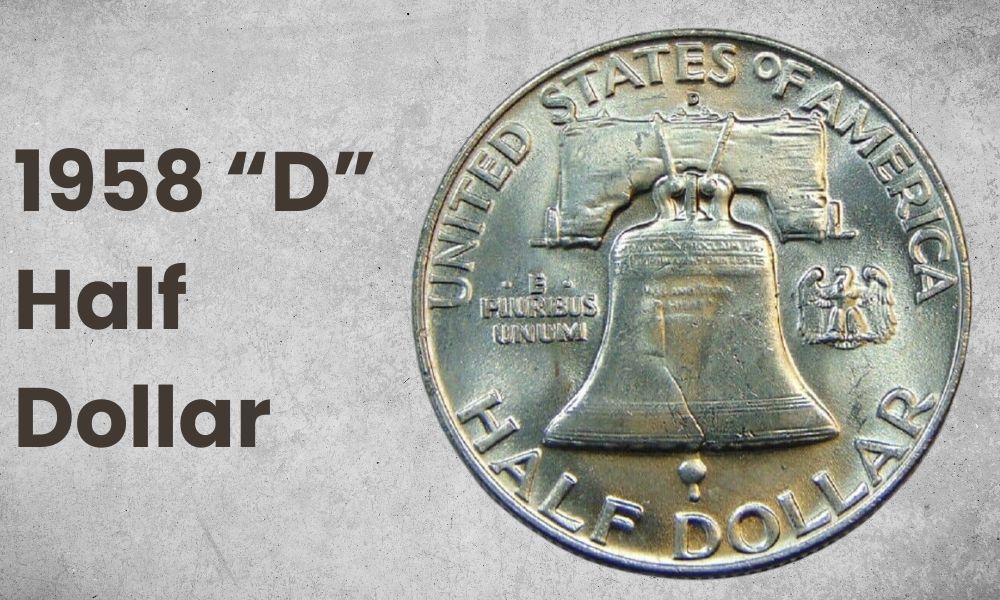
- Category: Franklin Half Dollar
- Mint: “D”
- Minting place: Denver
- Year: 1958
- Edge: Reeded
- Mintage: 23,962,412
- Designer: John R. Sinnock
- Originalvalue: 50 cents ($0.50)
- Current value: $6.95 to $9.55
- %Composition: 90% silver and 10% copper
- Mass: 12.5 g
- Diameter: 30.6 mm
In 1958, the Denver mint produced 23,962,412 Franklin half dollars. These had a tiny “D” mark above the Liberty bell in the coin’s reverse design, just below the “E” in “STATES”. Since these coins were many, they are still readily available today, even in mint state.
You can find an average circulated condition coin at $6 to $9. Some special ones can even go for $11; some mint states will share this price point. However, some rare and toned mint states can go for as high as $1,939.
Mint state examples with full bell lines (FBL) are even rarer and more expensive. It’s therefore not surprising that a PCGS MS67+ FB 1958 D 50-cent coin with toning went for a whopping $32,900 in a December 2020 auction.
1958 Half Dollar History
The Franklin half dollar was first minted in 1948 and it was produced each year until 1963. It is the 50-cent series with the shortest minting period. Its reign was cut short because of John F. Kennedy’s assassination in 1963; a new coin was designed to honor him.
Keep in mind that the Franklin half dollar was produced because the then Mint Director, Nellie Tayloe admired Benjamin Franklin.
As such, she instructed John R. Sinnock, to design the new 50-cent coin with Franklin’s image in 1947. After all, Sinnock had been the mint’s chief engraver from 1925 and had previously designed a medal with Franklin’s image.
Ultimately, he adapted this previous work to come up with the obverse design on the new half dollar. But Sinnock passed away in May 1947 before he finished the coin’s reverse design.
Gilroy Roberts had to finish the design for him. When the mint finally started producing the Franklin half dollars in 1948, few pieces were produced. This was because of low demand.
The half dollars produced in those first years were so few that all three minting facilities were not always used at the same time. For one, the San Francisco mint was closed in 1955 and remained that way until 1965.
On the other hand, the Denver facility didn’t strike any half dollars in 1955 and 1956. Ultimately, the economy started to improve in 1957 and the demand for half dollars started to rise.
Things particularly got better in 1962, leading to high half dollar mintages. If there’s one thing you need to know about Franklin half dollars though, it’s that there are two types: type I and type II.
The latter has a modification made to the eagle’s feathers in the reverse design. While type I has an eagle with four long tail feathers, type II has one with three feathers. Interestingly, the Franklin half dollars minted in 1958 and 1959 had some type I pieces and some type II ones.
And all the D mint dollars were type I coins. The type II coins make up a percentage of the no-mint half dollars minted in Philadelphia. For the 1958 dollars, this percentage is around 5% to 10%. For 1959 dollars, this percentage is around 70%.
1958 Half Dollar Grading
To appropriately grade the 1958 half dollar, you need to pay attention to its condition. You’ll have to look at things like the luster and lettering. If you’ve never done this before, consider taking your coin to a professional.
Whatever the case, your coin will eventually have to get a grading with a number from 1 to 70 and a definition like good, fine, or uncirculated. The higher the grade of your coin, the more valuable it is.
Lists of 1958 Half Dollar Error
1. 1958 Half Dollar Curved Clip
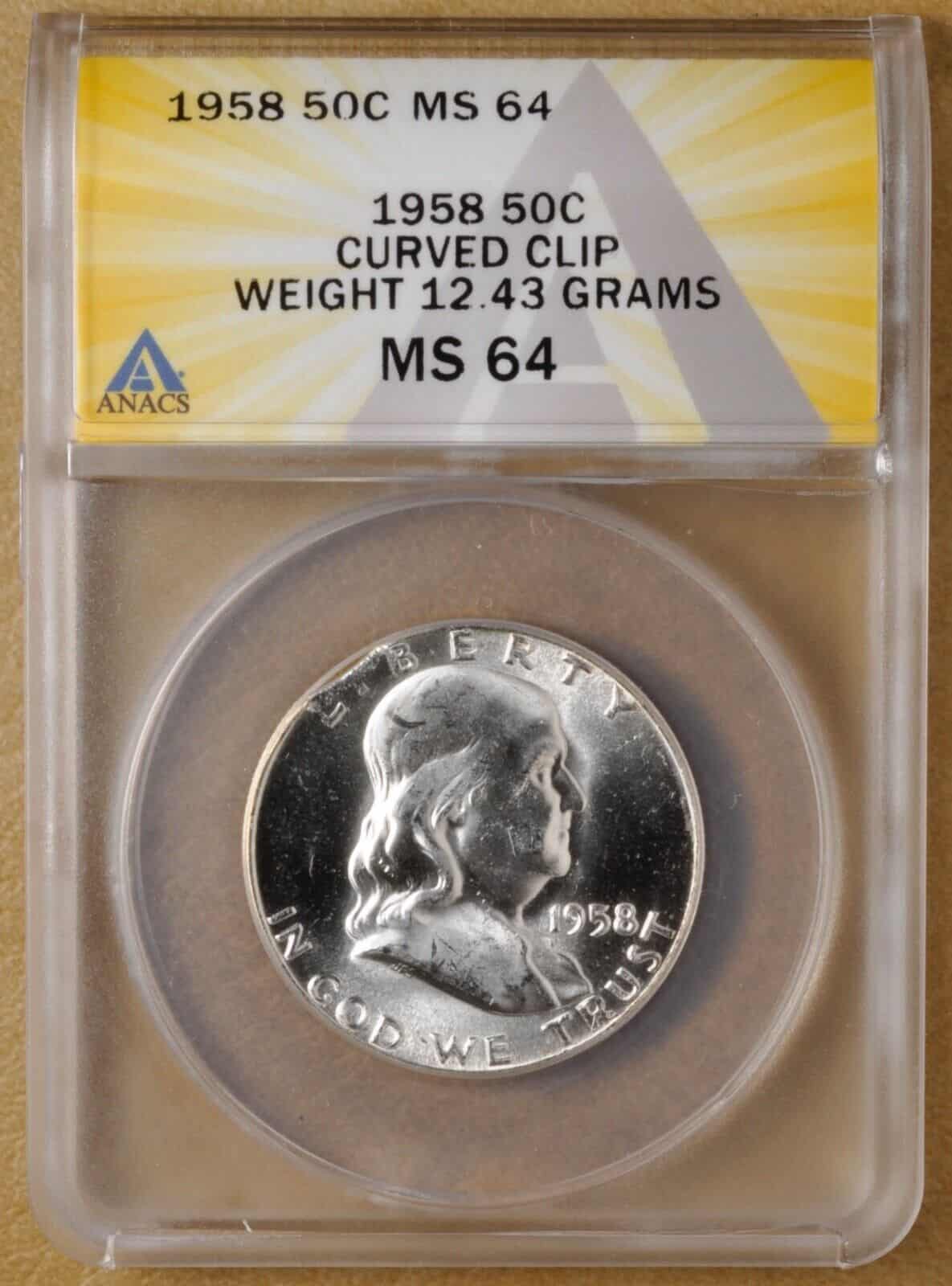
A curved clip is an error that occurs when a punched-out blank doesn’t get away from the blanking die fast enough and ends up with a curved perforation. This can make a coin more valuable.
An NGC MS65 1958 50-cent coin with this error sold for over $60 in an auction.
2. 1958 Half Dollar On Defective Planchet
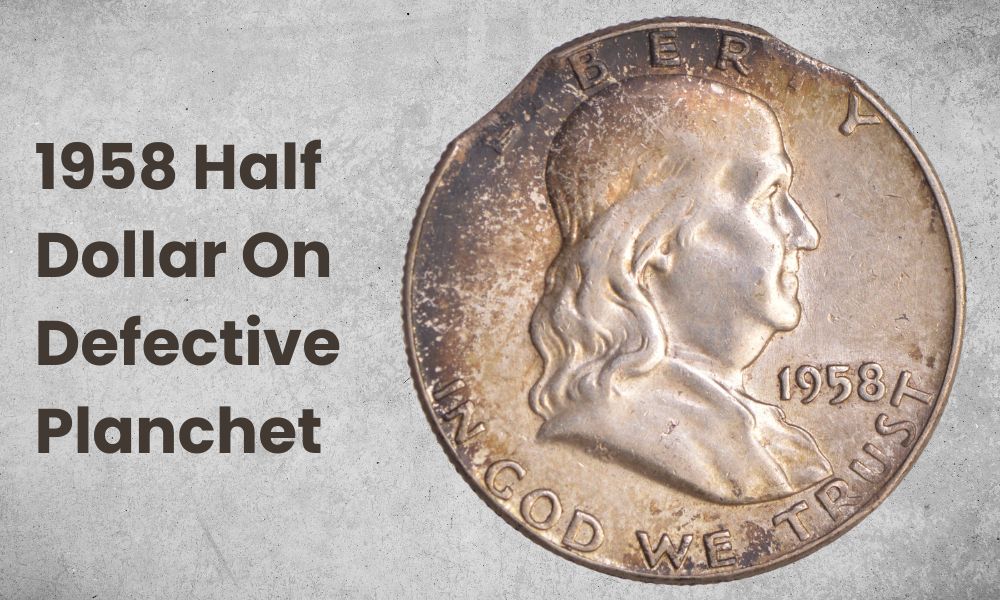
This error is caused by using a defective planchet to strike a coin. The planchet can be defective for a variety of reasons and can result in a cracked or scratched coin. Generally, the more dramatic the damage, the more valuable the coin.
An ANACS MS 63 1938 50-cent coin with a small undramatic version of this error can go for around $60. However, keep in mind that it’s difficult for a newbie to tell a defective planchet error by just looking at a coin.
After all, many other things can cause cracks and other forms of damage. As such, it’s best to get a professional to identify this type of error.
3. 1958 Half Dollar Struck on Wrong Planchet
As its name suggests, this error happens when a coin is struck on a planchet that was meant for a different coin type. This results in a design that doesn’t fit properly on the coin and an undesirable composition/weight.
This error can increase the coin’s value. An NGC MS64 FBL 1958 D 50-cent coin that was struck on a 25-cent planchet was once sold for over $2,200.
4. 1958 Half Dollar Partial Collar
When a planchet isn’t properly placed in the collar die, it ends up with a steeped edge; this is what is called a partial collar. This error can significantly increase the price of a coin. For instance, an AU58 1958 50-cent coin with this error can go for over $250.
1958 Half Dollar FAQ
Are 1958 half dollars silver?
1958 half dollars are made of 10% copper and 90% silver.
Where is the mint mark on a 1958 half dollar?
The 1958 half dollars produced at the Philadelphia facility don’t have any mint mark. However, the ones minted in Denver have a small “D” mark on their reverse side, above the Liberty bell. This is below the “E” on the inscription “STATES”.
What makes a Franklin Half Dollar valuable?
The most valuable feature a Franklin half dollar can have is full bell lines (FBL). However, since these lines are clearly visible on proof coins, professional graders only use them to determine the value of regular-strike uncirculated pieces.
How can you tell if a half dollar is rare?
If you want to tell whether a 50-cent coin is rare, check whether it’s a proof, error, or strange variation coin; these are usually rarer. Also, check its date and mint mark.
Generally, dates with lower mintages are rare, especially if they have a rare mint mark. Based on this principle, the 1873 S Seated Liberty with no arrows is the rarest half dollar today. Only 5,000 of these coins were minted and it’s believed that none of them survived.
This is because they were supposed to be melted down in 1873 when the US changed its standard weight of silver. If anyone found such a coin, they could sell it for over $1 million.
Other rare coins that you are more likely to come across are the 1796 and 1797 half dollars. A few of these have been found over the years and sold for thousands of dollars. Some even go for as high as $800,000.
What years of half dollars are silver?
The first half dollar was designed and minted in 1794. Dubbed the Flowing Hair half dollar, it was made of 90% silver. The design and composition were maintained until 1795.
In 1976, a new design was launched and was minted until 1807. This series of coins were called the Draped Bust half dollar. It had the same composition as the Flowing Hair half dollar.
The Draped Bust design was replaced by the Capped Bust one in 1808. This new coin was minted every year until 1839 and had 89.2% silver. The Seated Liberty design followed this one.
It was minted every year until 1891 and had 90% silver. In 1892, the Barber half dollar came in with the same composition. The Walking Liberty replaced it in 1916 and had the same composition.
Then came the Franklin half dollar in 1948 with again the same composition. In 1964, the Kennedy half dollar was released with the same composition. But this was changed in 1965 when the silver content was reduced to 40%; this continued until 1969.
In 1970, silver was removed from the coin; it was made of copper and nickel until its last minting year in 2002.
